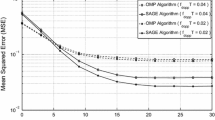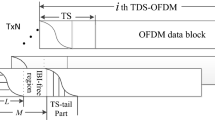Abstract
Multipath arrivals in an Ultra-WideBand (UWB) channel have a long time intervals between clusters and rays where the signal takes on zero or negligible values. It is precisely the signal sparsity of the impulse response of the UWB channel that is exploited in this work aiming at UWB channel estimation based on Compressed Sensing (CS). However, these multipath arrivals mainly depend on the channel environments that generate different sparse levels (low-sparse or high-sparse) of the UWB channels. According to this basis, we have analyzed the two most basic recovery algorithms, one based on linear programming Basis Pursuit (BP), another using greedy method Orthogonal Matching Pursuit (OMP), and chosen the best recovery algorithm which are suitable to the sparse level for each type of channel environment. Besides, the results of this work is an open topic for further research aimed at creating a optimal algorithm specially for application of CS based UWB systems.
Similar content being viewed by others
References
FCC 04-48. First Report and Order in the Matter of Revision of Part 15 of the Commission Rules Regarding Ultra-wideband Transmission Systems. 2002.
I. Oppermann, M. Hamalainen, and J. Iinatti. UWB Theory and Applications. John Wiley & Sons, West Sussex, England, 2004, 67–126.
R. Newaskar and A. P. Chandrakasan. A/D precision requirements for an ultra-wideband radio receiver. IEEE Workshop on Signal Processing Systems, San Diego, CA, USA, 2002, Vol. 1, 270–275.
A. Oka and L. Lampe. A compressed sensing receiver for UWB impulse radio in bursty applications like wireless sensor networks. Elsevier Physical Communication, Special Issue on Advances in Ultra-wideband Wireless Communications, 2(2009)4, 248–264.
Z. Peng, H. Zhen, R. C. Qiu, and B. M. Sadler. A compressed sensing based ultra-wideband communication system. Proceedings of IEEE International Conference on Communications (ICC), Dresden, Germany, 2009, 1–5.
Yu Huanan and Guo Shuxu. Pre-filtering ultra-wideband channel estimation based on compressed sensing. Proceedings of the 2010 International Conference on Communications and Mobile Computing (CMC’10), Washington DC, USA, 2010, 110–114.
E. Candes, J. Romberg, and T. Tao. Robust uncertainty principles: Exact signal reconstruction from highly imcomplete frequency information. IEEE Transactions on Information Theory, 52(2006)2, 489–509.
D. L. Donoho. Comressed sensing. IEEE Transactions on Information Theory, 52(2006)4, 1289–1306.
M. Mishali and Y. C. Eldar. From theory to practice: sub-Nyquist sampling of sparse wideband analog signals. IEEE Journal of Selected Topics in Signal Processing, 4(2010) 2, 375–39.
S. Gishkori, G. Leus, and V. Lottici. Compressive sampling based differential detection of ultra wideband signals. Proceedings of IEEE PIMRC 2010, Istanbul, Turkey, 2010, 189–194.
J. Haupt, W. Bajwa, G. Raz, et al.. Toeplitz compressed sensing matrices with applications to sparse channel estimation. IEEE Transactions on Information Theory, 56(2010)11, 5862–5875.
Z. G. Karabulut and A. Yongacoglu. Sparse channel estimation using orthogonal matching pursuit algorithm. 2004 IEEE 60th Vehicular Technology Conference, Los Angeles, CA, USA, 2004, Vol. 6, 3880–3884.
J. R. Foerster, M. Pendergrass, and A. F. Molisch. A channel model for ultrawideband indoor communication. Proceedings of Wireless Personal Multimedia Communication, WPMC-03, Kanagawa, Japan, 2003, Vol. 2, 116–120.
J. Foerster. Channel Modeling Sub-Committee Report Final. IEEE P802.15-02/368r5-SG 3a, 2002.
D. L. Donoho and M. Elad. Optimally sparse representation in general (nonorthogonal) dictionaries via l1-minimization. Proceedings of The National Academy of Sciences of the United Statas of Amenica, 100(2003), 2197–2202.
E. J. Candès and T. Tao. Decoding by linear programming. IEEE Transactions on Information Theory, 51(2005)12, 4203–4215.
S. S. Chen, D. L. Donoho, and M. A. Saunders. Atomic decomposition by Basis Pursuit. SIAM Journal on Scientific Computing, 20(1998)1, 33–61.
B. Mehmet, E. Serhat, and Ali C. Hakan. The effect of channel models on compressed sensing based UWB channel estimation. Proceedings of IEEE International Conference on Ultra Wideband (ICUWB’11), Bologna, Italy, 2011, 375–379.
S. Erküc, ük, D. I. Kim, and K. S. Kwak. Effects of channel models and Rake receiving process on UWB-IR system performance. Proceedings of IEEE International Conference on Communications (ICC’07), Glasgow, United Kingdom, 2007, 4896–4901.
S. M. Kay. Fundamentals of Statistical Signal Processing: Estimation Theory. Prentice-Hall, Upper Saddle River, NJ, USA, 1998, 595.
Author information
Authors and Affiliations
Corresponding author
Additional information
Communication author: Guo Shuxu, born in 1959, male, Professor.
About this article
Cite this article
Nguyen, T., Guo, S. & Chen, H. Effect of multipath channel models to the recovery algorithms on compressed sensing in UWB channel estimation. J. Electron.(China) 30, 254–260 (2013). https://doi.org/10.1007/s11767-013-2149-8
Received:
Revised:
Published:
Issue Date:
DOI: https://doi.org/10.1007/s11767-013-2149-8




